
Journal of Light & Laser Current Trends Category: Engineering
Type: Short Communication
Dynamic Thermal Optimization - An Intelligent Technology to Maximize the Consistency of Tissue Coagulation
*Corresponding Author(s):
Ki Uk SongIndependent Consultant, Manila, Philippines
Tel:?+63 22908530,
Email:virtuoso3016@gmail.com
Received Date: Oct 08, 2019
Accepted Date: Oct 15, 2019
Published Date: Oct 22, 2019
Abstract
For decades, non-ablative lasers from various media have been used in dermatology. The use of these lasers was advanced by the introduction of several technologies such as fractional and scanning technologies. Through these technologies, satisfying clinical results with minimized downtime and complications became feasible. However, there have been steady concerns on how practitioners can induce tissue coagulation in the best consistency because it varies depending on the temperature of treated skin despite the same amount of energy delivered, even at a certain fixed pulse width. As such, it has remained an unresolved question for decades.
Recently, one laser manufacturer resolved this challenge with its patented technology called Dynamic Thermal Optimization, which was applied to their latest product called JouleX Halo. Dynamic Thermal Optimization measures skin temperature and automatically adjusts the energy density and pulse width to the desired treatment parameters.
Dynamic Thermal Optimization helps practitioners replicate uniform and consistent treatment results. Through the real-time detection of skin temperature and a computerized program, practitioners do not need to measure skin temperature during treatment nor adjust parameter settings according to the visible reaction of treated skin. It is hoped that similar or even better technologies will be developed for and applied to more products in the future.
Recently, one laser manufacturer resolved this challenge with its patented technology called Dynamic Thermal Optimization, which was applied to their latest product called JouleX Halo. Dynamic Thermal Optimization measures skin temperature and automatically adjusts the energy density and pulse width to the desired treatment parameters.
Dynamic Thermal Optimization helps practitioners replicate uniform and consistent treatment results. Through the real-time detection of skin temperature and a computerized program, practitioners do not need to measure skin temperature during treatment nor adjust parameter settings according to the visible reaction of treated skin. It is hoped that similar or even better technologies will be developed for and applied to more products in the future.
Keywords
Cooling; Dynamic Thermal Optimization; Fractional coagulation; Microthermal zone
INTRODUCTION
For decades, non-ablative lasers from various media have been used in dermatology. The use of these lasers was advanced by the introduction of several technologies including, but not limited to, fractional and scanning technologies.
Fractional laser technology, often combined with scanning technology, is a great revolution of clinical laser applications for various indications. It creates a tissue coagulation zone, which comprises only 10%–20% of the whole treatment area, leaving the rest of the area untreated. Its benefit is a significant reduction of post treatment downtime and complications along with satisfying treatment results. However, there has always been a concern on whether there is a guarantee for the uniform and consistent creation of microthermal zones (MTZs), especially in cases where the skin temperature of the treated area keeps changing [1].
Some researchers found out that the lower skin temperatures commonly associated with the use of cooling during treatment cause a decrease in the depths and diameters of MTZs. In the study, the vertical and horizontal sizes of epidermal MTZs at different skin temperatures were measured. The result showed different measurement values, for example, the measurement at 45°C were significantly greater than the measurement at 0°C even at the same pulse energy of 10 mJ (Figures 1 & 2). The researchers concluded that the epidermal diameters of MTZs have a positive linear relationship with skin temperature, which means that the diameters of MTZs decrease when cooling is applied during treatment for patient comfort (Figure 3). This makes skin temperature change during treatment a very important variable factor, and it is believed that it could interfere with achieving uniform and consistent treatment results [2].
Fractional laser technology, often combined with scanning technology, is a great revolution of clinical laser applications for various indications. It creates a tissue coagulation zone, which comprises only 10%–20% of the whole treatment area, leaving the rest of the area untreated. Its benefit is a significant reduction of post treatment downtime and complications along with satisfying treatment results. However, there has always been a concern on whether there is a guarantee for the uniform and consistent creation of microthermal zones (MTZs), especially in cases where the skin temperature of the treated area keeps changing [1].
Some researchers found out that the lower skin temperatures commonly associated with the use of cooling during treatment cause a decrease in the depths and diameters of MTZs. In the study, the vertical and horizontal sizes of epidermal MTZs at different skin temperatures were measured. The result showed different measurement values, for example, the measurement at 45°C were significantly greater than the measurement at 0°C even at the same pulse energy of 10 mJ (Figures 1 & 2). The researchers concluded that the epidermal diameters of MTZs have a positive linear relationship with skin temperature, which means that the diameters of MTZs decrease when cooling is applied during treatment for patient comfort (Figure 3). This makes skin temperature change during treatment a very important variable factor, and it is believed that it could interfere with achieving uniform and consistent treatment results [2].
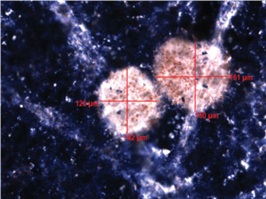 Figure 1: Exemplar epidermal MTZ after Fractional Photothermolysis performed at 45°C with a pulse energy of 10 mJ; 200× magnification. The measurements performed by the blinded investigator are shown in red. Adapted from [2].
Figure 1: Exemplar epidermal MTZ after Fractional Photothermolysis performed at 45°C with a pulse energy of 10 mJ; 200× magnification. The measurements performed by the blinded investigator are shown in red. Adapted from [2].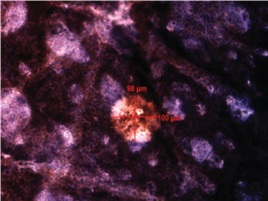 Figure 2: Exemplar epidermal MTZ after Fractional Photothermolysis performed at 0°C with a pulse energy of 10 mJ; 200× magnification. The measurements performed by the blinded investigator are shown in red. Adapted from [2].
Figure 2: Exemplar epidermal MTZ after Fractional Photothermolysis performed at 0°C with a pulse energy of 10 mJ; 200× magnification. The measurements performed by the blinded investigator are shown in red. Adapted from [2].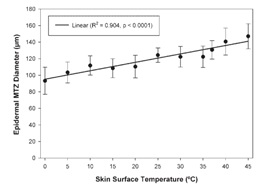 Figure 3: Temperature dependence of the epidermal MTZ diameter for pulse energy of 10 mJ. A linear regression graph is superimposed over the empirical data points. The error bars depict the standard deviation of the mean for each skin surface temperature. Adapted from [2].
Figure 3: Temperature dependence of the epidermal MTZ diameter for pulse energy of 10 mJ. A linear regression graph is superimposed over the empirical data points. The error bars depict the standard deviation of the mean for each skin surface temperature. Adapted from [2].AN INNOVATIVE TECHNOLOGY
Recently, one laser manufacturer has launched its latest product called JouleX Halo (Sciton, Inc., Palo Alto, CA), which comes with their patent technology called Dynamic Thermal Optimization. The technology ensures computerized control of the most appropriate laser energy densities and pulse widths that are automatically adjusted according to real-time skin temperature changes so that MTZs are uniformly and consistently created. In other words, it measures skin temperature using an infrared temperature sensor, and automatically changes the energy density and pulse width to ensure that the laser is always tuned to the desired treatment parameters (Figures 4 & 5).
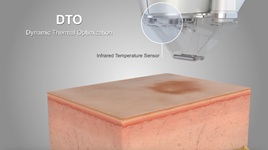
Figure 4: Dynamic Thermal Optimization involves the real-time measurement of the temperature of treated skin using an infrared temperature sensor.
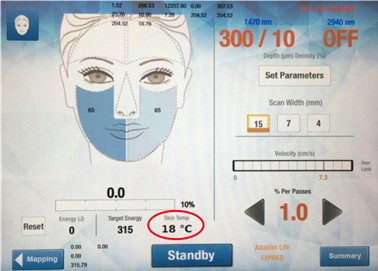 Figure 5: The temperature measured by the infrared temperature sensor is shown on the graphic user screen and, at the same time, is entered into a computerized program so that laser energy densities and pulse widths are automatically adjusted according to real-time skin temperature changes, ensuring that MTZs are uniformly and consistently created.
Figure 5: The temperature measured by the infrared temperature sensor is shown on the graphic user screen and, at the same time, is entered into a computerized program so that laser energy densities and pulse widths are automatically adjusted according to real-time skin temperature changes, ensuring that MTZs are uniformly and consistently created.Therefore, Dynamic Thermal Optimization helps practitioners replicate uniform and consistent treatment results regardless of temperature changes in the treated area (Figure 6). Through the real-time detection of skin temperature and a computerized program, practitioners do not need to measure skin temperature during treatment nor adjust the parameter settings according to the visible reaction of treated skin. However, it was also noted that Dynamic Thermal Optimization requires skillful manipulation of the handpiece at the most appropriate speed and vertical position; thus, sufficient learning curve period remains a major drawback of the technology.
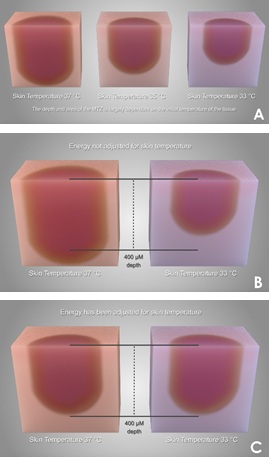 Figure 6: A) The depths and areas of MTZs are largely dependent on the temperature of treated skin. B) Without Dynamic Thermal Optimization, energy densities and pulse widths are not adjusted, thus resulting in MTZs created in different depths and areas. C) With Dynamic Thermal Optimization, energy densities and pulse widths are automatically adjusted, thus resulting in MTZs uniformly and consistently created.
Figure 6: A) The depths and areas of MTZs are largely dependent on the temperature of treated skin. B) Without Dynamic Thermal Optimization, energy densities and pulse widths are not adjusted, thus resulting in MTZs created in different depths and areas. C) With Dynamic Thermal Optimization, energy densities and pulse widths are automatically adjusted, thus resulting in MTZs uniformly and consistently created.CONCLUSION
Dynamic Thermal Optimization is a meaningful technology that ensures uniform and consistent treatment results by creating the desired depth and width of MTZs in treated skin. It is hoped that similar or even better technologies will be developed for and applied to more products in the future.
REFERENCES
Citation: Song KU (2019) Dynamic Thermal Optimization - An Intelligent Technology to Maximize the Consistency of Tissue Coagulation. J Light Laser Curr Trends 2: 005.
Copyright: © 2019 Ki Uk Song, et al. This is an open-access article distributed under the terms of the Creative Commons Attribution License, which permits unrestricted use, distribution, and reproduction in any medium, provided the original author and source are credited.

Journal Highlights
© 2024, Copyrights Herald Scholarly Open Access. All Rights Reserved!
